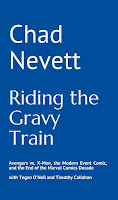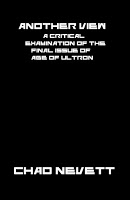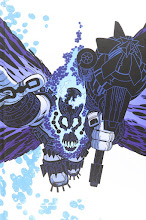 Thanks to Matthew J. Brady, I finally got a copy of the 2008 Krash Bastards graphic novel. It was a gift after I said something nice about his blog. How great is that? Say something nice about a blog you genuinely enjoy and you get a gift. Isn't Matt Brady a wonderful guy? And a great blogger, too. You should go read his blog. Then again, having read this book, I can see why he was so quick to say, "Chad, you read a lot of Joe Casey comics and I notice that you haven't discussed Krash Bastards. Well, I happen to have a copy of it and would love to give it to you so you can come one step closer to having read and written about this writer's entire body of work." It's not that this book is bad, it's just... not that good either. But we won't hold that against Matt, because I've read and discussed many comics by Casey that are worse than Krash Bastards.
Thanks to Matthew J. Brady, I finally got a copy of the 2008 Krash Bastards graphic novel. It was a gift after I said something nice about his blog. How great is that? Say something nice about a blog you genuinely enjoy and you get a gift. Isn't Matt Brady a wonderful guy? And a great blogger, too. You should go read his blog. Then again, having read this book, I can see why he was so quick to say, "Chad, you read a lot of Joe Casey comics and I notice that you haven't discussed Krash Bastards. Well, I happen to have a copy of it and would love to give it to you so you can come one step closer to having read and written about this writer's entire body of work." It's not that this book is bad, it's just... not that good either. But we won't hold that against Matt, because I've read and discussed many comics by Casey that are worse than Krash Bastards.Krash Bastards is an OEL manga. It reads right-to-left and opens as such; if you open it like a regular North American book, you're treated to a page that tells you what you should be doing. It's an odd choice and one that Casey has yet to repeat. Then again, no further volumes of Krash Bastards have come out. In his afterword, Casey discusses wanting to try and make manga, to write in that language and style, basically, to see if he can. I wish I could speak about his sucess a bit more, but I'm a Joe Casey expert, not much of a manga one (honestly, this is the only comic I own that reads right-to-left), so I can't speak to that success too much. It seems to hit on a lot of the superficial elements often associated with manga: young warriors, combining sci-fi and monsters, big spikey hair, Japanese-sounding names... The pacing is brisk with the most panels a single page has being six and that happens once. The vast majority of pages have four panels or less. In many ways, Krash Bastards comes off as a cynical, misguided attempt to rip off manga without really understanding it (says the guy that doesn't understand manga either). Take the Krash Bastards: there's the cool warrior leader, his hot girlfriend, his younger brother, the silent/deadly/mysterious member, and the older mentor. Pretty much the prototypical manga/anime group as far as I'm concerned. Their enemy, Kau Death, wears samurai armour; they fight primarily with swords while traveling in a spaceship; one of the big threats is a 'gekko god-being.' It reads like a book of cliches. Or, at least, all of the cliches that I, the unknowing manga neophyte, would think of.
But, it's also a Joe Casey comic and that's how I approached it. Krash Bastards is concerned with many of the usual ideas and themes of Casey's work, falling into line with The Intimates and Final Crisis Aftermath: Dance in its conception of youth and 'cool.' The Krash Bastards are the coolest kids on the playground (not literally), a group of warriors that people love and media darlings. Their leader and his girlfriend are the 'it' couple. They speak in dumb-sounding slang, concern themselves with their image more than anything it seems... even the storytelling relates to this superficial, vapid approach as rarely does Casey go beneath the surface. Even when he does, he puts it in the language of the extremely self-aware, the metafictional. The leader of the group, Tran Lo Zip confronts Kau Death alone at the end as a means to define himself as the greatest warrior in the universe, an ego-driven move to give his life purpose and meaning -- it's not enough to be the coolest of the cool when there's a big bad guy that can kick ass better. His girlfriend doesn't understand and, honestly, I don't think he really does either. He almost seems to do it because it's what a young warrior in his position does.
I said that Krash Bastards is steeped in manga cliches and I don't think that's accidental. Casey has shown in his career a purposeful use of cliches and genre/medium tropes to examine them. Here, he's using these ones for the first time and doesn't really go beyond the surface as he gets his footing. Tran Lo Zip's turn at the end doesn't inspire and engage, because it's artifical... he does it because it's what he should do. That's what this book feels like. For a first-time effort at manga, Casey goes through the superficial, the familiar, in an effort to understand it. Krash Bastards is more a working examination of the superficial elements of manga so that, in the future, he can go beyond the superficial. It's a test run, practice...
Why then was it published? Well, because you can't really see how well it works until it's drawn, can you? And what artist is going to draw a 72-page graphic novel for the purpose of allowing you to see how to write manga? In North American superhero comics, Casey was able to learn much quicker with shorter, 22-page stories. I'm sure manga comes out in a variety of lengths, but that's not necessarily the perception and Casey seems to want to engage that perception. For what purpose, I'm not entirely sure, which is why this book doesn't work.
The plot here is very basic and peppered with soulless action scenes. It's not helped by Axel #13's art, which is very stiff and lacks the frenetic craze of much manga, where the action practically leaps off the page since it's little more than energy. The compositions of pages and design work aren't bad. His gekko god-being is quite interesting to look at. One big annoyance is the lack of pupils in his characters' eyes. Early in the book, pupils are there, but they disappear quickly into the book and it looks really bad as we go on. The stiffness throughout really bothers me since so much here depends on heightened emotions and fast, energetic action scenes, and his art doesn't convey either well.
Finally, I must ask, "Should this work remain forgotten?" Yeah, probably. Joe Casey fans who happen to be more well-versed in manga may want to give it a look, but, otherwise, it will probably sit alongside those other mediocre-to-bad Casey books that I only (re)read for the purpose of scholarly study/analysis.






